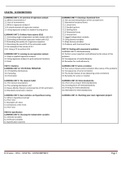Tentamen (uitwerkingen)
ECS3706 - Econometrics Questions And Answers With Summary Notes.
- Vak
- Instelling
ECS3706 - Econometrics Questions And Answers With Summary Notes. LEARNING UNIT 1: An overview of regression analysis 1.1 What is econometrics? 1.2 Uses of econometrics 1.3 What is regression analysis? 1.4 A simple example of regression analysis 1.5 Using regression analysis to explain housing ...
[Meer zien]



